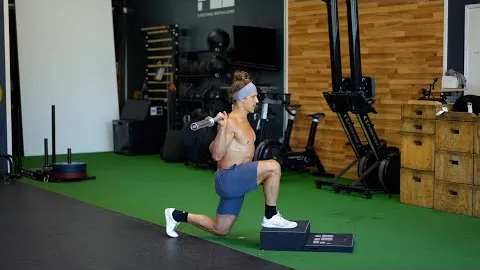
The Back Rack Front Foot Elevated Split Squat is a highly effective exercise that targets the lower body, specifically the quadriceps, glutes, and hamstrings. This compound exercise is great for developing strength, balance, and stability. Whether you are an athlete looking to enhance your performance or a fitness enthusiast aiming to build a strong lower body, incorporating the Back Rack Front Foot Elevated Split Squat into your workout routine can yield great results.
To perform the Back Rack Front Foot Elevated Split Squat, you will need a barbell and a squat rack. Here is a step-by-step guide on how to properly execute this exercise:
The Back Rack Front Foot Elevated Split Squat offers numerous benefits for individuals of all fitness levels and goals. Some of the key benefits include:
The Back Rack Front Foot Elevated Split Squat places a significant emphasis on the quadriceps and glute muscles. By elevating the front foot, this exercise creates a larger range of motion and requires greater activation from these muscle groups, resulting in increased strength and development.
Due to the unilateral nature of the exercise, the Back Rack Front Foot Elevated Split Squat helps address any strength imbalances between the left and right leg. This can lead to improved lower body strength, stability, and overall balance.
Maintaining proper balance and form during the Back Rack Front Foot Elevated Split Squat requires significant core engagement. The core muscles stabilize the body and help maintain an upright position, contributing to overall core strength and stability.
The movement pattern involved in the Back Rack Front Foot Elevated Split Squat mimics many real-life movements, such as climbing stairs or stepping up onto elevated surfaces. By training this movement pattern, you are enhancing your functional strength, making daily activities easier and more efficient.
The Back Rack Front Foot Elevated Split Squat is a safe exercise that can help prevent injuries by strengthening the muscles surrounding the knee joint. Strong quadriceps, glutes, and hamstrings can provide better stability and support, reducing the risk of knee-related injuries.
To reap the maximum benefits of the Back Rack Front Foot Elevated Split Squat, it is important to incorporate it strategically into your workout routine. Here are a few tips on how to integrate this exercise into your training:
Warm-up: Prior to performing the Back Rack Front Foot Elevated Split Squat, ensure you have warmed up your lower body with dynamic stretches and mobility exercises. This will help increase blood flow, improve flexibility, and prepare your muscles for the movement.
Proper Load Selection: Begin with a moderate weight that challenges you but allows you to maintain proper form throughout the exercise. Focus on technique and gradually increase the load as you become more comfortable with the movement pattern.
Repetition and Set Scheme: Aim for 3-4 sets of 8-12 repetitions on each leg. This rep and set scheme allows for sufficient muscle stimulation and promotes strength and hypertrophy gains.
Progressive Overload: To continue seeing progress, gradually increase the weight or difficulty of the exercise over time. This progressive overload principle ensures that your muscles continue to adapt and grow.
Rest and Recovery: Allow your body ample time to recover between workouts. The Back Rack Front Foot Elevated Split Squat places a significant demand on your lower body muscles, so be sure to prioritize rest and recovery to avoid overtraining.
The Back Rack Front Foot Elevated Split Squat is a highly effective exercise for developing lower body strength, stability, and muscle balance. By incorporating this compound movement into your training routine, you can expect to see improvements in quadriceps, glute, and hamstring strength. Remember to perform the exercise with proper form, gradually increase the load over time, and allow for adequate rest and recovery. With consistency and determination, the Back Rack Front Foot Elevated Split Squat can take your lower body training to the next level.
If you're looking for a gym, fitness club or yoga studio, you've come to the right place.
You can find information about gyms in your area. Browse catalog of gyms and find gyms with classes which are you looking for.
On gym page you can find simple information like address, phone or website. You can find list of available classes. You can check availability of personal training or small group classes. On place page you can also see information about open hours.
You can find gyms near you with amenities, courts, studios and equipments.
Use our map to find gym at your city or district.
In Gym Navigator you can find list of exercises with movies for many body parts.
You can browse exercises catalog and find exercises the best of you.
You can also find exercises grouped into workout plans, which you can use to improve you body. Each routine show you exercises one by one and give you possibility to count you progress and count down rest time.